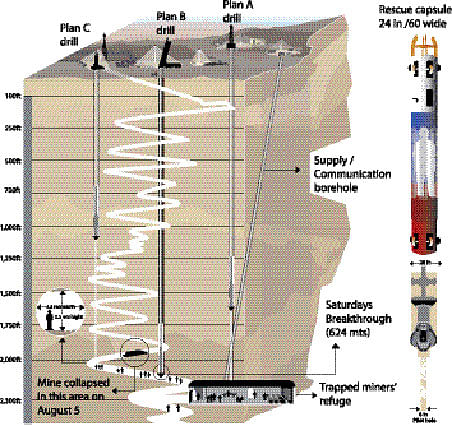
The world’s most elaborate and longest-ever rescue operation launched by the Chilean authorities immediately after the miners were found alive on August 22, 17 days after the mine collapse, made a crucial breakthrough early on Saturday as a borehole wide enough to hoist the miners to the surface reached the area where the miners have taken refuge.
Announcement
Sirens blasted through the site of rescue operations at the troubled San Jose copper and goldmine near Copiapo town of northern Chile early Saturday, announcing to anxious family members of the 33 miners that one of the three boreholes being drilled for weeks to bring the trapped men to surface had reached the underground tunnel area where they have taken refuge since August 5.
The announcement brought instant cheers and tears to the family members camping at the rescue site to hear this news.The borehole, referred to as Plan B, reached the target depth of 2,047 feet (625 metres), to an area of the 4.5 metre-wide mine tunnel to which the miners have access. “This is an important achievement,” Chile’s Mining Minister Laurence Golborne announced. But he cautioned that “…we still haven’t rescued anybody. This rescue won’t be over until the last person below leaves this mine.”
The rescuers would now test the stability of the 28-inch-diametre borehole to assess if it would require steel-casing before starting the actual rescue operations. In case the borehole requires complete or partial casing, the operation to lift the miners one by one would have to wait for a few days more.
Metal capsules
The rescuers have readied three special metal capsules equipped with telephone, oxygen, water and food to hoist the miners one at a time.
Each capsule has also an instrument which the miner inside will have to operate to negotiate through the curved borehole during the journey to freedom that may take up to 30 minutes. Only one of the capsules will be used and the other two will be in standby.
The rescuers on surface have been sending training instructions to the miners to prepare themselves for the treacherous journey.
The rescuers have pressed into service experts from around world, including from NASA, to train the miners — in every respect, including physical and psychological, using the telephone line set up through one of the narrower boreholes drilled to probe the fate of the miners.
The 6-inch-diametre borehole has been the lifeline for the miners as it is used to supply oxygen-mixed cool air, water, food and medicine to them since August 22. Before the first miner is pulled up, at least one commando from the Chilean navy will be lowered through the capsule to the tunnel area of the trapped miners to assess their medical condition and guide them in their journey to surface.
As part of the elaborate rescue plan, the rescuers are also simultaneously drilling two other boreholes — known as Plan A and Plan C. Though Plan A drilling was the first one started, it has encountered several problems, slowing down the work. The Plan C drilling, using a most sophisticated machine from Canada, was taken up the last. It has already drilled to a depth of over 350 metres. The work on these two will be abandoned if Plan B succeeds.
Anxious wait
The entire Chilean nation has been anxiously waiting for over two months and the plight of the 33 miners has attracted global attention as hundreds of media persons have camped at the rescue site for weeks to report the unprecedented operations.
The last time a similar operation undertaken was in Pennsylvania in the United States in 2002 to save nine coal miners trapped underground. But in this case, the nine coal miners were trapped 240 ft underground — just one-tenth of the present one.
The coal miners’ ordeal had last lasted for just four days.